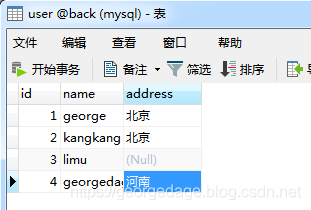mysql中的不等于怎么使用
mysql中的不等于
在mysql中的不等于,<>,!=,is not 多说无益,来个实例!!!
一个简单地表数据:

select * from user where address != "北京"

select * from user where address <> "北京"

select * from user where address = null

select * from user where address is null

select * from user where address != null

总结:
select * from user where address != "北京" select * from user where address <> "北京" select * from user where address = null select * from user where address is null select * from user where address != null select * from user where address is not null
短短几条语句,三个极其常见的点,或许我们在回答的时候却不知所措,犹豫不决。
在<>和!=是等价的。在某字段不等于某值(非空的值)时,输出的结果此字段为空不输出。
is 和 is not 用于和 null 结合,我称它为不是,不是空
补充:MySQL查询:不等于的使用方法(mysql查询不等于)
流行的关系数据库系统MySQL,它为从数据库中获取相关信息提供了一套SQL查询语句。通常,用户使用SQL查找特定项目,为了获取有用的结果,我们需要使用比较运算符,如果我们从数据库中查找不等于某个特定参数的时候,我们可以使用“不等于”运算符()操作。
“不等于”运算符在MySQL中可以用来比较字符串和数字值,它可用于形式的SELECT.. FROM语句和WHERE子句。
下面是一个例子,用来演示如何使用不等于运算符:
假设有一个表,叫做student,有一个字段是name,里面有几行记录..
| name |
|———–|
| John |
| Tom |
| Alex |
| Mark |
要从这些记录中找出name不等于Tom的记录,我们可以在where语句后面使用这样的查询:
SELECT * FROM student WHERE name ‘Tom';
运行上面的查询,结果表显示:
| name |
|———–|
| John |
| Alex |
| Mark |
最后,值得注意的是MySQL中还有一个叫做”!=”的不等于运算符,它的用法和“”的用法完全一样,所以可以随时使用它们互换,比如:
SELECT * FROM student WHERE name != ‘Tom';
结果也同样是:
| name |
|———–|
| John |
| Alex |
| Mark |
以上是mysql中的不等于怎么使用的详细内容。更多信息请关注PHP中文网其他相关文章!

热AI工具

Undresser.AI Undress
人工智能驱动的应用程序,用于创建逼真的裸体照片

AI Clothes Remover
用于从照片中去除衣服的在线人工智能工具。

Undress AI Tool
免费脱衣服图片

Clothoff.io
AI脱衣机

AI Hentai Generator
免费生成ai无尽的。

热门文章

热工具

记事本++7.3.1
好用且免费的代码编辑器

SublimeText3汉化版
中文版,非常好用

禅工作室 13.0.1
功能强大的PHP集成开发环境

Dreamweaver CS6
视觉化网页开发工具

SublimeText3 Mac版
神级代码编辑软件(SublimeText3)

热门话题
 mysql用户和数据库的关系
Apr 08, 2025 pm 07:15 PM
mysql用户和数据库的关系
Apr 08, 2025 pm 07:15 PM
MySQL 数据库中,用户和数据库的关系通过权限和表定义。用户拥有用户名和密码,用于访问数据库。权限通过 GRANT 命令授予,而表由 CREATE TABLE 命令创建。要建立用户和数据库之间的关系,需创建数据库、创建用户,然后授予权限。
 MySQL:初学者的数据管理易用性
Apr 09, 2025 am 12:07 AM
MySQL:初学者的数据管理易用性
Apr 09, 2025 am 12:07 AM
MySQL适合初学者使用,因为它安装简单、功能强大且易于管理数据。1.安装和配置简单,适用于多种操作系统。2.支持基本操作如创建数据库和表、插入、查询、更新和删除数据。3.提供高级功能如JOIN操作和子查询。4.可以通过索引、查询优化和分表分区来提升性能。5.支持备份、恢复和安全措施,确保数据的安全和一致性。
 忘记数据库密码,能在Navicat中找回吗?
Apr 08, 2025 pm 09:51 PM
忘记数据库密码,能在Navicat中找回吗?
Apr 08, 2025 pm 09:51 PM
Navicat本身不存储数据库密码,只能找回加密后的密码。解决办法:1. 检查密码管理器;2. 检查Navicat的“记住密码”功能;3. 重置数据库密码;4. 联系数据库管理员。
 MySQL 中的查询优化对于提高数据库性能至关重要,尤其是在处理大型数据集时
Apr 08, 2025 pm 07:12 PM
MySQL 中的查询优化对于提高数据库性能至关重要,尤其是在处理大型数据集时
Apr 08, 2025 pm 07:12 PM
1.使用正确的索引索引通过减少扫描的数据量来加速数据检索select*fromemployeeswherelast_name='smith';如果多次查询表的某一列,则为该列创建索引如果您或您的应用根据条件需要来自多个列的数据,则创建复合索引2.避免选择*仅选择那些需要的列,如果您选择所有不需要的列,这只会消耗更多的服务器内存并导致服务器在高负载或频率时间下变慢例如,您的表包含诸如created_at和updated_at以及时间戳之类的列,然后避免选择*,因为它们在正常情况下不需要低效查询se
 navicat premium怎么创建
Apr 09, 2025 am 07:09 AM
navicat premium怎么创建
Apr 09, 2025 am 07:09 AM
使用 Navicat Premium 创建数据库:连接到数据库服务器并输入连接参数。右键单击服务器并选择“创建数据库”。输入新数据库的名称和指定字符集和排序规则。连接到新数据库并在“对象浏览器”中创建表。右键单击表并选择“插入数据”来插入数据。
 mysql怎么复制表
Apr 08, 2025 pm 07:24 PM
mysql怎么复制表
Apr 08, 2025 pm 07:24 PM
在 MySQL 中复制表需要创建新表、插入数据、设置外键、复制索引、触发器、存储过程和函数。具体步骤包括:创建具有相同结构的新表。将数据从原始表插入新表。设置相同的外键约束(如果原始表有)。创建相同索引。创建相同触发器(如果原始表有)。创建相同存储过程或函数(如果原始表使用了)。
 Navicat for MariaDB如何查看数据库密码?
Apr 08, 2025 pm 09:18 PM
Navicat for MariaDB如何查看数据库密码?
Apr 08, 2025 pm 09:18 PM
Navicat for MariaDB 无法直接查看数据库密码,因为密码以加密形式存储。为确保数据库安全,有三个方法可重置密码:通过 Navicat 重置密码,设置复杂密码。查看配置文件(不推荐,风险高)。使用系统命令行工具(不推荐,需要对命令行工具精通)。
 mysql怎么查看
Apr 08, 2025 pm 07:21 PM
mysql怎么查看
Apr 08, 2025 pm 07:21 PM
通过以下命令查看 MySQL 数据库:连接到服务器:mysql -u 用户名 -p 密码运行 SHOW DATABASES; 命令获取所有现有数据库选择数据库:USE 数据库名;查看表:SHOW TABLES;查看表结构:DESCRIBE 表名;查看数据:SELECT * FROM 表名;






